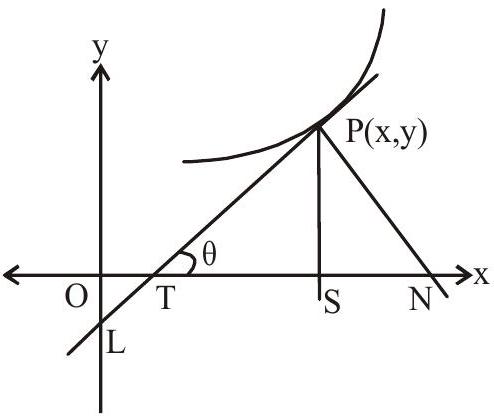Differential Equations - Order, Degree, Solution of a Differential Equation (Lecture-01)
An equation involving independent variable
A differentiable equation involving derivatives with respect to single independent variable is called ordinary differentiable equation.
A differentiable equation involving derivatives at least two independent variables and partial derivatives with respect to either of these independents variables is called a partial differentiable equation.
Order of a differential equation is the order of the highest order derivative present in it.
Degree of a differential equaiton is the degree of the highest order derivative present in it after the differential equation has been expressed as a polynomial of derivatives.
Formation of a Differential equaiton
In order to obtain a differential equation whose solution is
Solution of a Differential Equation
1. Variable separable form
Consider the equation
Now integrate both sides we get the solution.
Note: If the equation is of the form
General form of variable separation
If we can write the differential equation in the form
2. Homogeneous Differential Equation
General form is
Rule :
- Put
- Reduce to variable separable form and then solve.
Note : Equation of the form

Solution is
3. Linear differential equation

4. Bernoullis differential equation

Note: If
5. Excact differential equation
i.e. To solve
Note : Sometimes a differential equation of the form
Note : Sometimes transformation to the polar coordinates facilitates separation of variables. Remember the following
If
i.
ii.
iii.
Orthogonal Trajectory
Any curve which meet each member of a given family of curves at right angles is called an orthogonal trajectory of the family.
eg.
Working Rule
i. Let
ii. Differentiate given equaiton w.r.t
iii. Put
iv. Solve this differential equaiton to obtain the orthogonal trajectory.
Differential equation of first order and higher degree
i. Equation solvable for
If the equation
Integrate and find the general solution.
ii. Equations solvable for
Differentiating
Note : If it is difficult to eliminate
iii. Equation solvable for
Differentiating w.r.t. y,
Solution is obtained by elimating
Note : If it is difficult to eliminate
iv. Clarauts Equation
If a first order (any degree) differential equation is first degree in
Its solution is given by
Geometrical Applications
i. Equation of tangent at

Equation of normal at
iii. Length of tangent
iv. Length of normal
v. Length of subtangent
vi. Length of sub normal
Some standard forms to solve differential equaitons (For finding out the integrating factors by inspection).
1.
2.
3.
4.
5.
6.
7.
8.
9.
10.
11.
12.
13.
14.
15.
16.
17.
18.
19.
20.
Solved Examples
1. Solution of the differential equation
(a)
(b)
(c)
(d) None of these
Show Answer
Solution :
Integrating both sides,
Now
Answer. a
2. The solution of
(a)
(b)
(c)
(d) None of these
Show Answer
Solution :
Integrating we get,
gives
Answer. a
3. The solution of
(a)
(b)
(c)
(d) None of these
Show Answer
Solution :
Integrating we get,
Answer. b
4. The solution of
(b)
(c)
(d)
Show Answer
Solution:
Integrating
Answer. c
5. The solution of
(a)
(b)
(c)
(d) None of these
Show Answer
Solution:
Answer. c
6. Solution of the differential equation
(a)
(b)
(c)
(d) None of these
Show Answer
Solution:
Integrating we get
Answer. a
Exercise
1. A solution of the differential equation
(a)
(b)
(c)
(d)
Show Answer
Answer: c2. If
(a) 3
(b) 2
(c) 1
(d) 0
Show Answer
Answer: a3. Let
(a)
(b)
(c)
(d)
Show Answer
Answer: a4.* Tangent is drawn at any point
(a) differential equation of the curve is
(b) differential equation of the curve is
(c) curve is passing through
(d) normal at
Show Answer
Answer: b, c5.* Let
(a)
(b)
(c)
(d)
Show Answer
Answer: a, b6. A curve passing through the point
(a)
(b)
(c)
(d) none of these
Show Answer
Answer: b7. Let
(a) 0
(b) 1
(c) 5
(d) none of these
Show Answer
Answer: a8. If the function
(a)
(b) 2
(c) 0
(d) none of these
Show Answer
Answer: b9. Match the following :-
| Column I | Column II | ||
|---|---|---|---|
| (a) | The differential equation formed by | (p) | |
| differentating and eliminating constants from | |||
| where |
|||
| degree of the differental equation represened | (q) | ||
| by |
|||
| (b) | The order and degree of the differential | (r) | |
| equation, whose general solution is given by | |||
| are arbitrary constants, are |
(s) | ||
| (c) | The order and degree of the differential | ||
| equation satisfying | |||
| are |
(t) |
Show Answer
Answer:10. Read the following passage and answer the questions that follow :The differential equation
Note : (a) If p is eliminated between polution (1) \& (2) the solution obtained is a general solution of (1)
(b) If
i. Which of the following is about solutions of differential equation
(a) The general solution of equation is family of parabolas.
(b) The general solution of equation is family of circles.
(c) The singular solution of equation is circle.
(d) The singular solution of equation is ellipse.
ii. The number of solutions of the equation
(a) 1
(b) 2
(c) 4
(d) 0
iii. The singular solution of the differential equation
(a)
(b)
(c)
(d)










